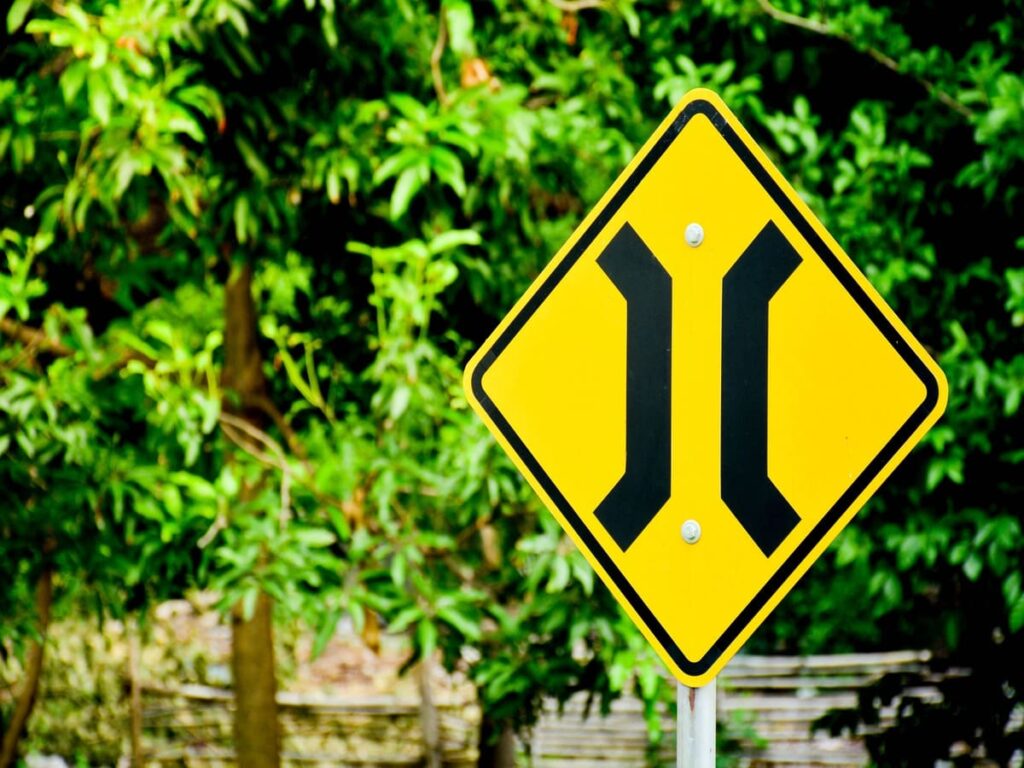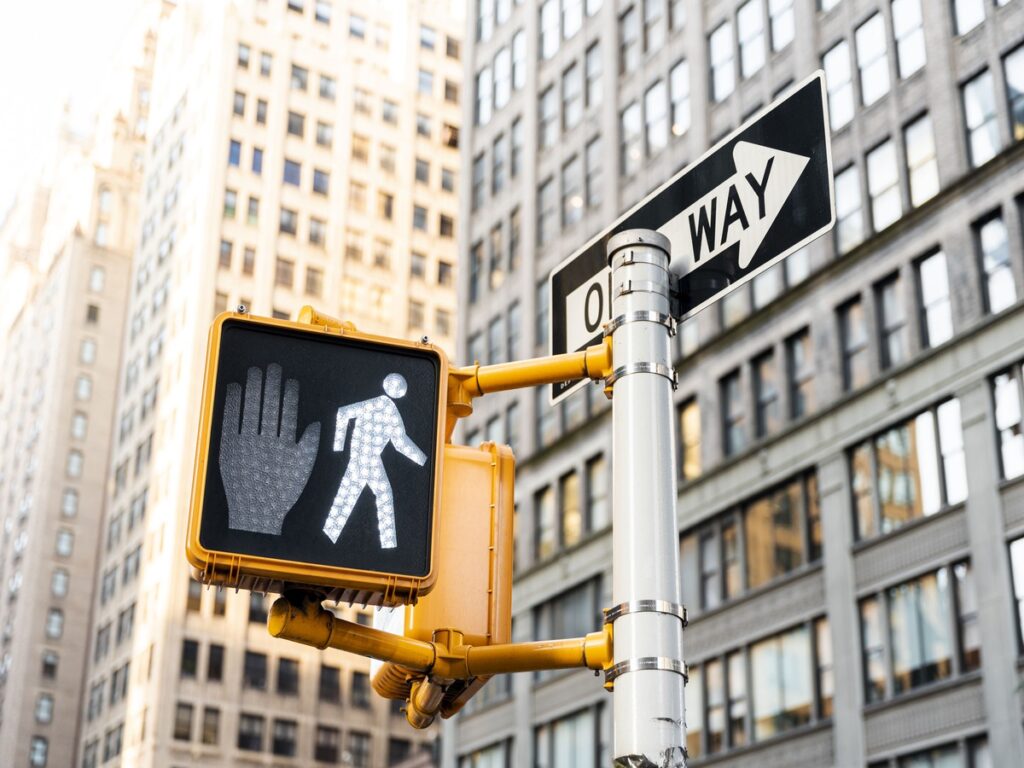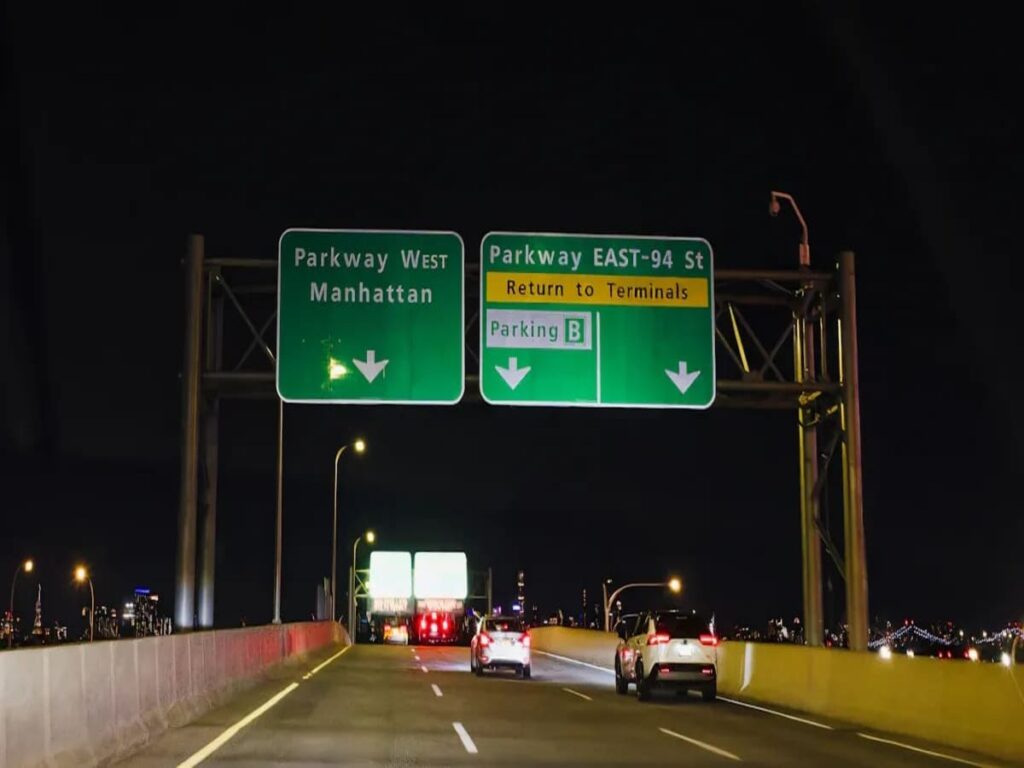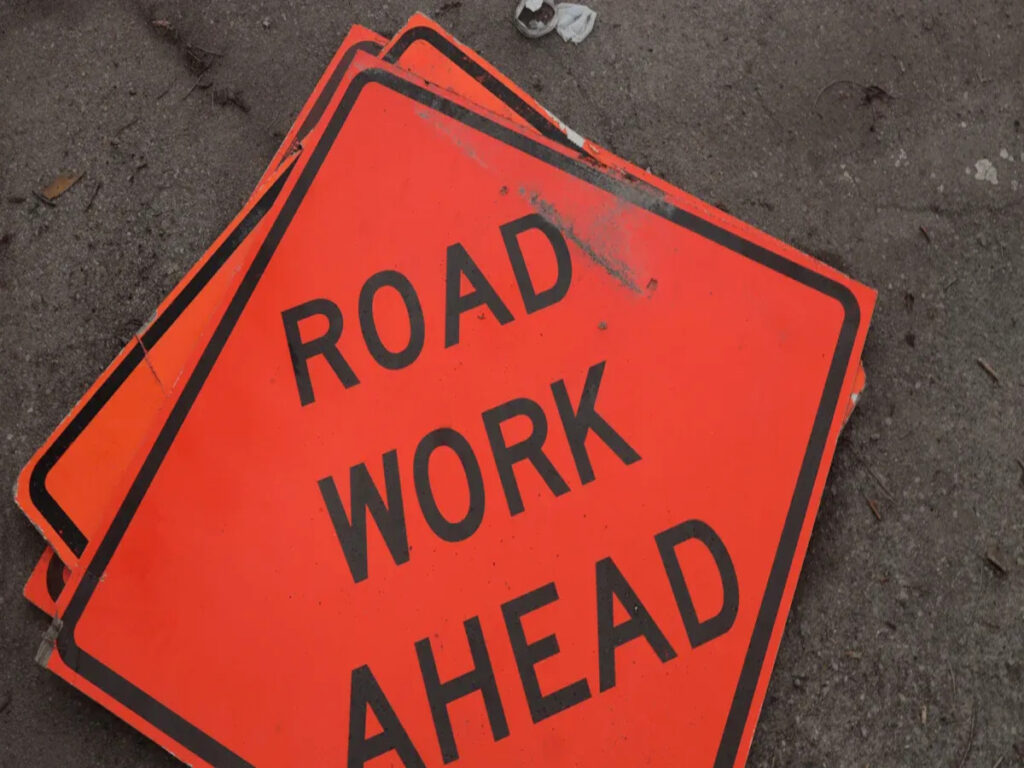
La segnaletica in Australia è molto importante per la sicurezza pubblica. Questo è vero nei luoghi in cui c'è più rischio. Ogni anno, Di 122 le persone affogano sulla costa. Molti di questi sono giovani adulti e visitatori di altri paesi. Spesso non vedono o comprendono messaggi di sicurezza importanti. Molte persone non leggono o notano segni, anche alle spiagge. Questo dimostra perché è necessario un linguaggio chiaro. I segnali di sicurezza australiani hanno due lavori principali. Si assicurano che le persone seguano la legge e aiutano a guidare tutti. Le parole su questi segni possono avvertire il pericolo o dare consigli utili. Questi segni mescolano le regole con l'insegnamento per aiutare gli obiettivi WHS.
A Optraffic, Comprendiamo che l'efficacia di a Segno di sicurezza del traffico risiede sia nel suo design che nel suo messaggio. Ecco perché garantiamo che i nostri segnali di sicurezza in vendita non siano solo conformi agli standard australiani, ma anche realizzati per essere visivamente chiari e linguisticamente inclusivi, quindi ogni messaggio è visto, inteso, e ha agito.
Segni di sicurezza australiani

Ruolo legale
I segnali di sicurezza australiani sono fondamentali per seguire la legge. Puoi vederli nei luoghi di lavoro, parchi, e luoghi divertenti. Questi segni ricordano alle persone Regole WHS. Aiutano a ridurre il rischio mostrando le regole e cosa succede se le rompi. La legge dice che devi usare determinati segni per il pericolo, Pericolo, e rischio. Troverai questi segni nei cantieri, fabbriche, e parchi nazionali. Per esempio, Un segnale di rischio di scossa elettrica pericolosa ti dice del pericolo elettrico. Mostra anche che non devi entrare senza permesso. Segni come “Solo personale autorizzato” O “Nessuna voce - pericolo” Aiuta le persone a seguire le regole WHS. Se qualcuno ignora questi segni, Possono mettersi nei guai. I segni si adattano anche alla teoria delle finestre rotte. Questa teoria dice che i chiari segni di avvertimento e pericoli rendono i luoghi più sicuri. Impediscono anche alle persone di fare cose rischiose nelle comunità australiane.
Un sondaggio nei parchi nazionali del Nuovo Galles del Sud mostra perché i segni sono importanti per la gestione del rischio legale. La tabella seguente mostra quali passi di sicurezza i visitatori pensano siano i migliori:
| Categoria di misura di sicurezza | Descrizione | Numero di intervistati (N) | Percentuale (%) |
|---|---|---|---|
| Controlli ingegneristici | Barriere e scherma intorno aree pericolose | 137 | 59.6 |
| Segnaletica | Segnali di avvertimento che indicano punti fotografici sicuri e non sicuri | 67 | 29.1 |
| Altro | Include il rafforzamento di pattuglie di sicurezza e altre misure | 20 | 8.7 |
| Responsabilità individuale | Enfasi sul fatto che i visitatori siano sensibili e consapevoli | 13 | 5.2 |
| Istruzione e applicazione | Richiede un'istruzione migliore e multe per un comportamento rischioso | 5 | 2.2 |
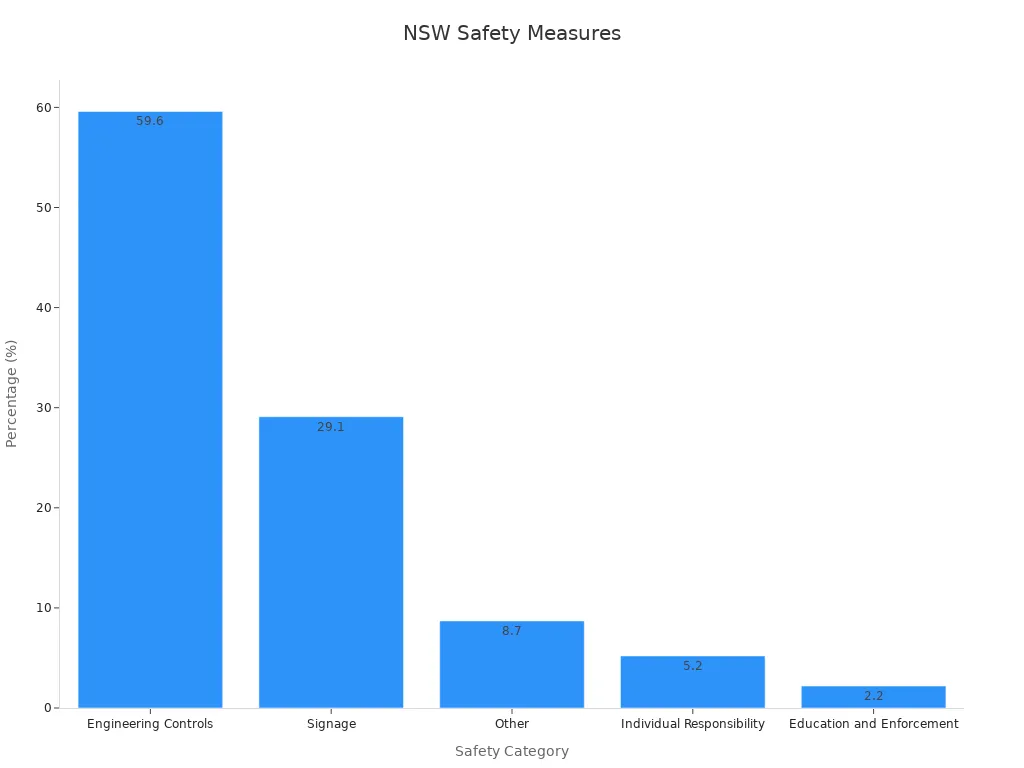
Guida pubblica
I segnali di sicurezza australiani aiutano anche le persone fornendo informazioni chiare. Ti raccontano di pericolo, rischio, e pericolo. I segni usano parole e immagini facili in modo che tutti possano capire. Questo aiuta le persone che non parlano bene l'inglese. Per esempio, Un segnale di rischio di shock elettrico pericoloso utilizza colori e immagini luminose. Questo avverte le persone sul pericolo elettrico e aiuta a fermare gli incidenti. Gli studi dimostrano che i buoni segni aiutano le persone a prestare attenzione e seguono le regole WHS. Ricerca di Wang et al.. E Shieh e Huang dicono quel colore, misurare, e i simboli chiari fanno funzionare meglio i segnali di avvertimento. I segni fanno più che avvertire del pericolo. Insegnano anche alle persone come stare al sicuro ed evitare pericoli e rischi ogni giorno.
I segni australiani spesso usano più di una lingua. Questo è comune in luoghi con molti visitatori di altri paesi. Da questa parte, I messaggi WHS raggiungono più persone e aiutano a coloro che hanno una diversa consapevolezza del rischio. Mescolando le regole legali con l'aiuto pubblico, I segnali di sicurezza australiani rendono luoghi più sicuri. Aiutano anche gli obiettivi WHS.
Tipi di lingua dei segni
Linguaggio giudiziario
Il linguaggio giudiziario su un segno usa parole molto chiare e rigorose. Questi segni avvertono le persone che potrebbero avere problemi legali se infrangono le regole. Per esempio, Un segno potrebbe dire, “Soggetto ad arresto” O “I trasgressori saranno perseguiti.” Le parole rendono molto chiaro i risultati di infrangere la regola. Questi segni usano parole standard per assicurarsi che tutti capiscano il messaggio. Le persone vedono questi segni e sanno che potrebbero essere perseguiti se non seguono la regola. L'effetto legale avviene immediatamente. Il segno è sia un avviso che un avviso legale. Il segno fa anche sentire le persone preoccupate di mettersi nei guai. Questo li rende più propensi a seguire la regola. Le parole sul cartello mostrano potere e fanno attenzione alle persone.
Nota: Il linguaggio giudiziario è spesso utilizzato in luoghi ad alto rischio, Come i cantieri o le aree in cui le persone non sono ammesse. Le parole devono adattarsi alle regole e agli standard legali WHS.
Linguaggio informativo
Il linguaggio informativo su un cartello dà alle persone fatti e consigli. Le parole raccontano alla gente il rischio e cosa dovrebbero fare. Per esempio, Un segno potrebbe dire, “Area limitata - Zona scolastica. Le persone non autorizzate possono essere perseguite.” Questo segno racconta alla gente la zona e cosa potrebbe accadere se infrangono la regola. Le parole sono chiare ma non così spaventose. Le parole standard in questi segni aiutano le persone a sapere perché la regola è lì. L'effetto legale è ancora lì, Ma il segno insegna anche alle persone. Il segno fa sentire bene le persone perché vengono fornite informazioni. Le persone hanno maggiori probabilità di seguire la regola quando la capiscono.
Luoghi di lavoro che utilizzano segni informativi in diverse lingue hanno avuto 25% meno incidenti di lavoro. Ciò dimostra che informazioni chiare e buone parole aiutano le persone a seguire le regole WHS. Il segno aiuta a guidare le persone e le avverte di procedimenti giudiziari. Le parole aiutano le persone a seguire le regole e stare al sicuro.
| Tipo di segno | Formulazione di esempio | Impatto legale | Effetto psicologico |
|---|---|---|---|
| PRECUDENZIONE | Soggetto ad arresto | Immediato | Autorità, urgenza |
| Informativo | Area limitata - Zona scolastica. Le persone non autorizzate possono essere perseguite | Presente, educativo | Rispetto, comprensione |
Quadro giuridico

Le leggi WHS
Le leggi australiane WHS sono la base per le regole di sicurezza. Queste leggi affermano che i datori di lavoro devono utilizzare i segnali di sicurezza. I segni devono soddisfare standard rigorosi. Le regole di salute e sicurezza del lavoro sono utilizzate in ogni stato e territorio. Ogni stato ha le sue regole WHS, Ma le idee principali sono le stesse. A regolatori come Lavoro sicuro in Australia Controlla se le organizzazioni seguono le leggi. Visitano siti e guardano i record. Parlano anche con i lavoratori. Se trovano problemi, Possono dare multe o fermare il lavoro. Il lavoro non può ricominciare fino a quando il sito è sicuro. I regolatori aiutano anche le aziende a capire cosa devono fare. Leggi sulla salute e sulla sicurezza del lavoro cerca di mantenere tutti al sicuro dai danni. Seguire queste leggi non è una scelta. È qualcosa che devi fare. Le leggi australiane WHS coprono molte cose. Questo include segni, formazione, e controlli di rischio. I regolatori cambiano le leggi quando compaiono nuovi rischi o tecnologia.
AS1319:2004 Standard
IL COME 1319:2004 standard aiutare con la progettazione di segnali di sicurezza. Queste regole dicono quali colori, forme, e simboli da usare. Questo rende i segni facili da vedere e da capire. I regolatori usano queste regole per verificare se i segni sono legali. Seguire come 1319:2004 fa parte delle leggi WHS. Gli standard parlano di diversi tipi di segni. Questi includono il pericolo, avvertimento, e segni obbligatori. Ogni tipo ha le sue regole di progettazione. I segni di pericolo usano il rosso, nero, e bianco per grandi rischi. Le regole dicono anche dove mettere i segni in modo che le persone possano vederli. I regolatori controllano i siti per assicurarsi che i segni seguano le regole. Se un segno è sbagliato, I regolatori possono chiedere modifiche. I buoni segni aiutano a mantenere le persone al sicuro al lavoro. Gli standard australiani WHS rendono luoghi più sicuri per tutti. Seguire queste regole aiuta a soddisfare gli obiettivi della legge WHS e smette di problemi legali.
Nota: I regolatori sono importanti per assicurarsi che le leggi WHS siano seguite. Aiutano dando consigli e verificando se le organizzazioni seguono le regole.
Design del segno
Linguaggio e simboli
I segni di sicurezza australiani usano parole chiare e simboli forti. Questi aiutano a mostrare pericoli e messaggi di avvertimento. Ogni segno deve seguire le regole rigorose per la formulazione. Le regole assicurano che i segni utilizzino parole semplici e simboli facili. Questo aiuta le persone di molti luoghi a capire rapidamente il pericolo. I designer scelgono simboli che corrispondono al pericolo. Per esempio, Un fulmine significa scosse elettriche. Una fiamma significa rischio di incendio. Le parole sono spesso audaci per rendere l'avvertimento facile da vedere.
I ricercatori usano modi diversi per verificare se i segni funzionano bene:
- Questionari e interviste chiedono alle persone se i segni sono chiari.
- I test comportamentali controllano quanto velocemente le persone reagiscono ai segni.
- Strumenti di neuroscienza, Come EEG, Guarda come il cervello vede i segni.
- Gli esperimenti mostrano segni con parole e simboli sono più facili da notare.
- Alcune forme e simboli, Come i triangoli, fare in modo che le persone reagiscano più velocemente agli avvertimenti.
Dove metti un segno è anche importante. Se un segno è a livello degli occhi e vicino al pericolo, La gente lo vede prima. Un buon posizionamento segue le regole e aiuta le persone ad ascoltare l'avvertimento.
Colore e forma
Il colore e la forma sono molto importanti per i segnali di sicurezza australiani. Le regole dicono quali colori usare per ogni pericolo. Rosso significa pericolo o non fare qualcosa. Giallo significa fare attenzione. Blu significa che devi fare qualcosa. Anche le forme contano. I triangoli significano avvertimento. Cerchi significano che devi fare qualcosa. I rettangoli forniscono informazioni. Il colore e la forma aiutano le persone a conoscere il pericolo prima di leggere le parole.
Un nuovo studio ha verificato il modo in cui le persone hanno capito i segni per colore e forma. La tabella seguente mostra quante persone hanno capito ogni gruppo:
| Gruppo di segni | Comprensione media (%) | Deviazione standard (%) | Note sui criteri standard soddisfatti |
|---|---|---|---|
| Media generale | 67.41 | 18.27 | Paragonabile al criterio ISO (66.7%) |
| Segni antincendio | 74.70 | 11.89 | Più alto tra i gruppi; Alcuni segni incontrano ANSI (85%) |
| Segni obbligatori | 70.20 | 10.26 | Diversi segni superano 67% criterio |
| Segni di divieto | 62.65 | 8.67 | Alcuni segni di seguito 67% criterio |
| Segni di emergenza | 70.93 | 10.54 | Livelli di comprensione mista |
| Segnali di avvertimento | 58.58 | 8.37 | Livelli di comprensione più bassi |
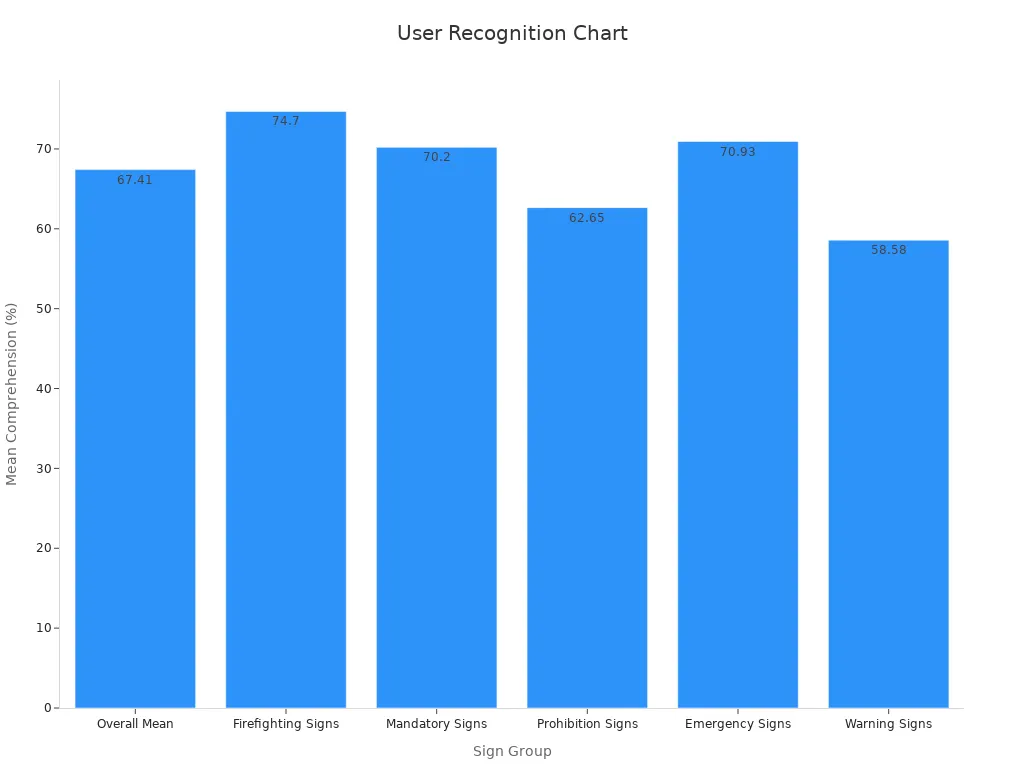
Lo studio trovato 14 fuori da 20 I segni raggiunti almeno 67% comprensione per forma e colore. Sette segni, Piace "Vietato fumare" E "Estintore", segnato 85%. Ciò dimostra che l'uso del giusto colore e forma aiuta le persone a notare i pericoli. Buon design dei segni, Con il posto giusto, parole, e simboli, Mantenere tutti al sicuro e li aiuta a seguire le regole.
Accusa vs. Istruzione
Azioni di applicazione
I regolatori in Australia hanno un lavoro importante. Controllano se i luoghi di lavoro e le aree pubbliche seguono le leggi WHS. Cercano luoghi che non usano le regole di sicurezza. Se trovano un problema, Possono dare un avvertimento o una multa. A volte, Possono persino smettere di lavorare per proteggere le persone. Questi passaggi aiutano tutti a seguire le regole e stare al sicuro. I regolatori usano segnali di sicurezza per mostrare dove esiste un rischio. Si assicurano anche che i segni seguano gli standard australiani WHS. Se un luogo non utilizza i segni giusti, I regolatori chiedono modifiche.
IL Politica nazionale di conformità e applicazione Aiuta i regolatori a decidere cosa fare. Dice loro quando usare regole rigorose o quando insegnare alle persone. La politica li aiuta a scegliere tra un avvertimento o una multa. Spiega anche cosa fare se qualcuno infrange le regole molte volte. I regolatori usano l'accusa se le persone continuano a ignorare i segni di sicurezza o le leggi WHS. Vogliono dimostrare che la sicurezza è molto importante e le regole devono essere seguite.
Ora, I regolatori usano più tecnologia per verificare se vengono seguite le regole. Usano telecamere e record digitali per guardare le azioni di sicurezza. Questo li aiuta a trovare problemi più velocemente. I regolatori lavorano anche con altri gruppi per condividere informazioni sui rischi. Questi passaggi aiutano a mantenere alti gli standard australiani WHS e rendono più semplice l'applicazione.
Nota: Le azioni di applicazione non riguardano solo la punizione. Ricordano a tutti che la sicurezza è il lavoro di tutti.
Approcci educativi
L'istruzione è una parte importante del sistema australiano WHS. I regolatori non solo puniscono le persone. Insegnano anche sulla sicurezza e le leggi WHS. Gestiscono seminari e distribuiscono volantini con informazioni facili. Questi materiali spiegano perché i segnali di sicurezza sono importanti e come usarli. I regolatori visitano scuole e luoghi di lavoro per parlare di sicurezza. Usano storie vere per mostrare cosa succede se le persone ignorano i segni.
Molti regolatori usano social media e siti Web per condividere suggerimenti di sicurezza. Pubblicano video e immagini per spiegare le regole WHS. Questo aiuta le persone a imparare in modo semplice. I regolatori rispondono anche alle domande del pubblico. Vogliono che tutti sappiano perché seguire le regole contano. Una buona istruzione aiuta le persone a ricordare le regole di sicurezza e seguirle ogni giorno.
Le leggi australiane WHS affermano che i datori di lavoro devono formare i lavoratori sulla sicurezza. Questa formazione insegna a leggere i segni e cosa fare. I datori di lavoro devono tenere i registri per mostrare ai lavoratori comprendere le regole. I regolatori controllano questi record quando visitano. Se trovano problemi, Chiedono più formazione. L'istruzione aiuta le persone a seguire le regole e significa meno bisogno di procedimenti giudiziari.
Mancia: Informazioni chiare e una formazione regolare aiutano le persone a rimanere al sicuro e seguire le leggi WHS.
Le autorità in Australia usano sia l'accusa che l'istruzione. Sanno che le regole rigorose funzionano meglio quando le persone capiscono anche perché. Utilizzando sia l'applicazione che l'educazione, I regolatori aiutano a costruire una cultura sicura e seguita dalle regole.
Fattori culturali e psicologici
Contesto australiano
L'Australia fa le cose in modo diverso per WHS e sicurezza. Le persone in Australia amano l'equità e le regole chiare. I regolatori usano i segni per mostrare dove si trova il pericolo. Questi segni aiutano tutti a sapere cosa fare. Molte persone in Australia provengono da altri paesi. Alcune persone non parlano bene l'inglese. I segni di sicurezza usano spesso simboli e colori per mostrare il pericolo. Questo aiuta tutti, Anche se non riescono a leggere l'inglese. L'Australia ha molti pericoli naturali come gli incendi, inondazioni, e sole forte. I regolatori hanno messo in segno i segni per avvertire di questi pericoli. Mettono segnali di sicurezza nei parchi, spiagge, e luoghi di lavoro. Questi segni aiutano le persone a stare lontano dai rischi e a stare al sicuro. La cultura dell'Australia rende la sicurezza un obiettivo per tutti. Le persone si fidano dei regolatori per dare buoni consigli sul pericolo e il pericolo.
Nota: Australia si preoccupa di WHS e della sicurezza perché ha dovuto affrontare rischi per molto tempo.
Impatto sulla conformità
I segni di sicurezza in Australia aiutano le persone a seguire le regole. Quando le persone vedono un segno chiaro, prestano più attenzione. I regolatori usano segni per ricordare alle persone le regole WHS. Questi segni aiutano le persone a ricordare di evitare il pericolo e agire in sicurezza. Gli studi mostrano che le persone seguono le regole WHS di più quando i segni sono semplici e usano simboli forti. I segni che avvertono sul pericolo fanno fermare e pensare le persone. Questo aiuta a fermare gli incidenti e protegge le persone. I regolatori controllano se le persone seguono le regole WHS. Usano i segni per aiutare le persone a seguire le regole e ridurre il rischio. In Australia, Le persone rispettano i segni WHS perché sanno che il pericolo è reale. I buoni segni aiutano le persone a fare scelte sicure ogni giorno.
- Segni di sicurezza in Australia:
- Avvertire il rischio e il pericolo
- Aiuta le persone a evitare il rischio
- Supportare la conformità WHS
La forte cultura WHS australiana e i chiari segnali di sicurezza aiutano tutti a rimanere al sicuro dal pericolo e dal rischio.
Segno di rischio di scossa elettrica pericolosa
Aspetti legali e informativi
Il segnale di rischio di shock elettrico pericoloso è un buon esempio di come i segni australiani mescolano le regole con l'aiuto per il pubblico. Vedrai questo segno in cui c'è un grande pericolo elettrico. Il segnale di rischio di shock elettrico pericoloso utilizza colori vivaci come il rosso, nero, e bianco. Questi colori fanno notare le persone rapidamente il segno. C'è un simbolo del fulmine sul segno. Questo simbolo avverte tutti sulla scossa elettrica. Le parole sul segno ti raccontano del rischio e del pericolo. Questo aiuta le persone a sapere cosa significa immediatamente il segno del rischio di scosse elettriche.
Le parole sul segnale di rischio di shock elettrico pericolose non si limitano al semplice avvertimento. Spiegano cosa potrebbe accadere se ignori il segno. Il segno spesso dice, “Pericolo: Rischio di scossa elettrica - Solo personale autorizzato.” Questo messaggio fornisce una regola legale. Solo le persone addestrate possono andare nella zona. Il segno ti racconta anche del rischio, Quindi sai perché devi stare fuori. Questo mix di parole legali e utili aiuta le persone a seguire le regole e imparare.
I progettisti devono seguire le regole rigorose quando si effettuano il segnale di rischio di scosse elettriche pericolose. Il segno deve usare simboli standard e parole chiari. La forma e il colore aiutano le persone a vedere il pericolo velocemente. Il segno del rischio di scossa elettrica significa la stessa cosa in ogni posto di lavoro. Questo aiuta tutti a capire il rischio, Anche se non parlano bene l'inglese.
Buoni segnali di sicurezza elettrica, Come il segnale di rischio di scosse elettriche pericolose, aiutare a fermare gli incidenti. Il segno ricorda ai lavoratori e ai visitatori del rischio. Aiuta anche i datori di lavoro a fare ciò che dice la legge. Il segnale di rischio di scossa elettrica pericolosi significa che devi stare lontano dal pericolo elettrico a meno che tu non abbia il permesso. Questo segno mantiene le persone al sicuro e aiuta a rendere il posto di lavoro più sicuro.
Mancia: Controlla sempre il segnale di rischio di scossa elettrica pericolosa prima di avvicinarsi alle apparecchiature elettriche. Il segno aiuta a mantenere tutti al sicuro dai danni.
I segni di sicurezza australiani mescolano le regole con consigli utili. Questo aiuta le persone a seguire la legge e stare al sicuro. Funziona in luoghi di lavoro e luoghi pubblici. La tabella seguente mostra come i segni di sicurezza migliorano le cose. Accadono meno incidenti e le persone sono più pronte per il pericolo:
| Metrica | Prima dei segni | Dopo i segni |
|---|---|---|
| Tasso di incidenti registrabili totale | 4.2 | 2.1 |
| Prontezza alla sicurezza (%) | 68 | 89 |
| Incidenti prevenuti | 12 | 27 |
Quando le persone continuano a conoscere i segni di sicurezza, seguono di più le regole. Questo aiuta a mantenere tutti al sicuro e smette di incidenti.
Domande frequenti
Qual è lo scopo principale dei segnali di sicurezza australiani?
I segnali di sicurezza australiani aiutano a mantenere le persone al sicuro. Avvertono di pericoli e rischi. Questi segni aiutano anche le persone a seguire la legge sul lavoro e in pubblico.
In che modo i segnali di sicurezza supportano l'applicazione legale?
I segni di sicurezza mostrano regole che tutti devono seguire. Aiutano le autorità a garantire che le persone obbediscano alle leggi. I segni avvertono anche di ciò che accade se infrangi le regole.
Perché i segni australiani usano sia simboli che parole?
I simboli aiutano le persone a capire il messaggio velocemente. Le parole forniscono maggiori dettagli sul rischio. Questo aiuta le persone che parlano altre lingue o non leggono bene.
Chi controlla se i segni di sicurezza soddisfano gli standard legali?
I regolatori visitano i luoghi e guardano i segnali di sicurezza. Controllano se i segni seguono le regole australiane. Se i segni sono sbagliati, I regolatori chiedono modifiche.
Quali sono alcune sfide nell'applicazione di WHS relative ai segnali di sicurezza?
Alcune persone non notano o comprendono i segni. I regolatori hanno problemi quando i segni non sono chiari o mancanti. Insegnare alle persone e controllare i segni spesso aiuta tutti a seguire le regole.

